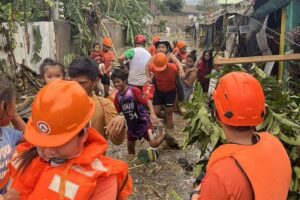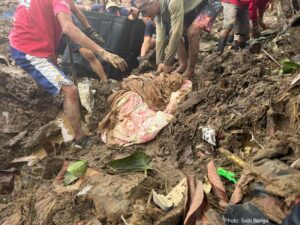Flash Floods and Mudslides Unleash Fury at Mount Kanlaon’s Foot

DUMAGUETE CITY, Philippines – The city of Canlaon has been officially placed under a state of calamity after Typhoon Tino unleashed torrential rains and deadly flash floods on November 3, causing massive destruction and a mounting human toll. As of Thursday, the official death count has tragically climbed to 16, with an additional 11 individuals still missing, according to local authorities.
The disaster struck swiftly. Heavy rainfall began the evening of November 2, but Tino’s intensity peaked around noon the following day. Rivers overflowed their banks, bridges buckled, and devastating mudslides—a mix of thick mud, massive boulders, and debris—tore through communities nestled at the foot of Mount Kanlaon.
In the immediate aftermath, rescuers faced a nightmarish landscape. Bodies were discovered buried beneath the debris, carried down by the raging currents from mountain streams. Streets in the city proper transformed into ferocious rivers of soil and stone, swallowing homes within seconds.
The Speed of the Disaster
Eyewitness accounts highlight the terrifying speed of the catastrophe. A survivor from Barangay Malaiba, who narrowly escaped by clinging to a fallen tree, recounted the horror:
“It happened so fast. We only heard the rumbling, and then the flood was already inside our house. There was no time to prepare.”
The sheer volume of water and earth carried down from the slopes of Mount Kanlaon overwhelmed the city’s natural and man-made defenses, illustrating the destructive power of Tino’s unprecedented intensity. (Related: The National Disaster Risk Reduction and Management Council (NDRRMC) reported that over 2 million Filipinos were affected by Typhoon Tino nationwide.)
Non-Stop Search and Rescue Efforts

Search and rescue operations are continuing non-stop, running day and night against a challenging backdrop of unstable terrain and persistent rainfall. Mayor Batchuk Cardenas confirmed the state of calamity and emphasized that the city’s resources are being channeled into two main priorities: the retrieval of the missing and the urgent clearing of critical roads and waterways.
“Even at night, work continues to ensure everyone’s safety,” Mayor Cardenas stated, assuring residents that desilting operations—the crucial work of removing the vast amounts of soil and stone from streets and waterways—are proceeding at full speed.
As of Thursday, logistical challenges remain significant. Communication lines in many barangays are intermittent, and electric power is still widely down. City officials have identified the most immediate needs for displaced families as:
Potable water
Food packs
Temporary shelters
Solidarity Amidst Devastation
Despite the widespread loss, stories of resilience and solidarity are emerging from the evacuation centers. Community kitchens have quickly been set up, and residents are pooling resources, sharing limited food supplies, and using generators to charge essential devices. More importantly, neighbors and friends are offering emotional comfort to those who are still desperately searching for missing loved ones.
In response to the tragedy, the Office of the President has pledged ₱10 million (10 million Philippine Pesos) in direct financial aid to support Canlaon’s recovery efforts. Private groups have also quickly mobilized, organizing both online fundraising drives and on-site relief missions.
The determination of the local community and the relief teams is palpable. As one local rescuer, his uniform heavily smeared with mud after a long shift, put it:
“It’s hard, but we will not stop. Until we find them all.”
Canlaon City now faces a long, arduous path toward recovery, underpinned by the hope that solidarity and continued aid will prevail over the destructive legacy of Typhoon Tino.



